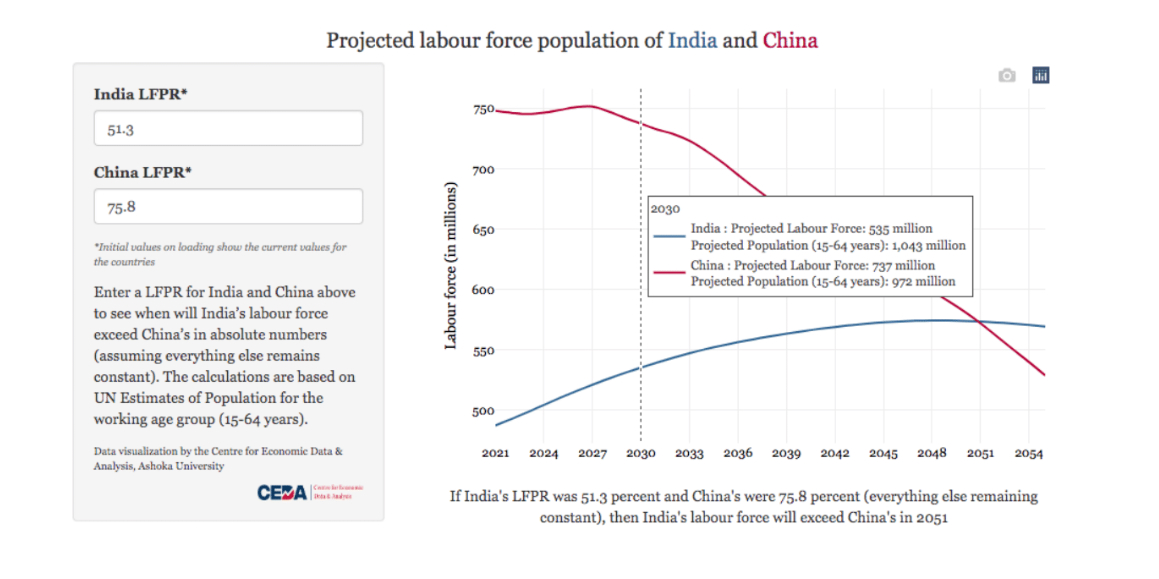August 03, 2023 – ASHWINI DESHPANDE, AKSHI CHAWLA
NEW DELHI–India is all set to overtake China and become the most populouscountry on the planet by July2023. One implication of this is that potentially, India’slabour force would soon be larger than China’s. If the productive capacity of India’smassive labour force is effectively harnessed, India could be on its way to becomethe new Asian giant. The Elephant would finally overtake the Dragon. Or would it?
However, the story isn’t so straightforward.
For one thing, India’s bigger population size will not translate to a larger working agepopulation for the country (vis-à-vis China) immediately (Figure 1).
Figure 1
While India’s total demographic cohort would be bigger than China’s by the end of2023, China willstill have a bigger working age population (those aged 15-64) foranother two years. It is only in 2025 that there will be more people aged between15-64 in India (994.7 million) than in China (987.4 million).

But not all people in the working age group are in the labour force, which comprises employed individuals and those willing to work but not employed (i.e., unemployed). For that we must look at the labour force participation rate, or LFPR. India’s LFPRs are not only much below the global average, but significantly lower than China’s. As of 2021 (the latest year for which comparable data is available), 75.8 percent of China’s working age population (15-64) was part of its labour force i.e. they were either employed, or looking for work, data from the International Labour Organisation’s (ILO) modelled estimates show. In India, on the other hand, only 51.3 percent of those in this age group were part of the labour force in the same year.
Figure 2
Much of this difference is driven by the chasm between the female labour force participation rates in the two countries. India has lower rates of both male and female labour force participation compared to China, but the gap is much bigger for female LFPRs. In 2021, 76.2 percent of Indian men (15-64) were part of its labour force, and in China this share was 80.5 percent. In the same year, only 24.6 percent of women (15-64) were part of the labour force in India, in sharp contrast to 70.8 percent in China.
This difference in LFPR essentially means that in 2021, while there were 986.5 million people in China aged 15-64, there were 747.9 million people who were employed or looking for employment, our calculations show. In India, on the other hand, there were 950.2 million people aged 15-64 in 2021, but only 487.9 million were part of the labour force (Figure 3).
Given the wider gap in FLFPR, this difference was starker for the female population, our calculations show. In 2021, China had an estimated 478.3 million women aged 15-64, and its female labour force was an estimated 338.6 million in size. In India, the female labour force was only 112.8 million in comparison even though it had 458.2 million women in that age group.
Figure 3: Estimated working age (15-64 years) population and labour force, India and China, 2021 (in millions)

So, while India’s working age demographic group was almost comparable in size to China’s, its labour force was significantly smaller, largely due to its much lower rates of female labour force participation. In this context, when is India likely to overtake China’s labour force? Not anytime soon.
If we assume constant LFPR rates as the most recent ones for both countries, it will take another 27 years for that to happen. It is only in 2051 when India will have more people in the labour force (15-64) than China (assuming everything else remains constant). These calculations are based on UN populations estimates available for all years up till 2100.
Figure 5
If India’s LFPR were to increase to 60 percent, this could happen by 2040. (Users can enter different LFPR values in Figure 4 to see how this timeline changes in different scenarios).
For India’s labour force to exceed China’s in absolute numbers by 2030, India’s LFPR would need to increase sharply from the current level of roughly 58 percent (the labour force participation rate by usual status for the 15-64 age group as estimated by the Periodic Labour Force Survey, 2021-22) to 71 percent for the next seven years. There is no reason to believe that such drastic improvement could be achieved in a short span of time. Any increase in overall LFPR is contingent upon on improving the share of women in the labour force, which is not impossible, but would need a dedicated set of comprehensive initiatives.
What about India’s demographic and gender dividends? The mere existence of a larger working age population does not constitute a demographic dividend. For it to be a dividend, first, the working age population must be in the labour force. Second, they must be productively employed. Otherwise, a large number of people in the working age group who are not productively employed can represent a huge challenge as the unfulfilled need for livelihood opportunities is a sure-fire recipe for discontent and unrest which can enhance conflict.
India is already grappling with a jobs crisis, as roughly 5.5 million new jobs that the country needs are not getting created, which makes agriculture the sector of last resort for people to eke out a livelihood.
Additionally, India is already grappling with low female LFPRs. One reason responsible for the low levels is undercounting of women’s economic work on family enterprises. Accounting for this work raises LFPR estimates, as India’s official Economic Survey has attempted to do. While recognizing women’s (unpaid) contribution to family enterprises is very important, it is not a substitute for paid work, the opportunities for which are not growing as rapidly as needed. There is dire need for expansion of rural non-farm employment, both for men and women, but especially crucial for women as they are unable to travel long distances to access work, due to their predominant responsibility for domestic chores.
China’s rapid growth was in no small measure due to one element of their economic reforms: the expansion of rural industry via the Township and Village Enterprises (TVEs) that absorbed its massive workforce in small, labour intensive, nonfarm work opportunities. Between 1978 (the start of the economic reforms) and 1995, China’s rural industries grew over 20 percent per year, raising their share in industrial production from 3 percent in 1971 to 30 percent in 1990.
This is the bus that India seems to be missing. If there isn’t enough remunerative work for young people and women, a very large potential pool of talent will remain un- or underutilized and the much-vaunted demographic dividend will remain illusory for India.
The other big contrast between the two countries is seen in the training/skill differences of the population. While in both countries, gross enrolment ratio for tertiary education (GETR) has been increasing, India’s GETR in 2021 was roughly half that of China in 2021 (Figure 5).
Not only does China have a higher GETR compared to India for both men and women, but the relative difference has also increased over recent years. In 2015, China’s GETR was 1.7 times that of India. By 2021, it was twice the level of India. The female gap remained roughly constant over the period (from 1.9 to 2.1), whereas the male gap increased from 1.6 to two.
The Elephant-Dragon Tango will continue. A sober reflection reveals that while India will become the most populous country, it is not about to overtake China in terms of a bigger and more educated labour force. This is not to suggest that the continued growth of the Chinese economy is free of its own set of challenges. In addition to battling geo-political challenges to its global expansion plans, China has to deal with a shrinking labour force, ageing population and boosting productivity growth. How acutely these challenges affect the Chinese rate of growth is a) a subject matter for another article and b) something only time will tell. This piece focuses on the Elephant-Dragon comparison.
Increasing female LFPRs, not only via correctly measuring women’s work, but via creation of an ecosystem that provides remunerative and sustainable livelihoods close to home (read rural nonfarm employment) and investing in an educated, skilled and healthy workforce should be India’s top priority, based on its own demographic reality, not just because of a presumed competition with China.
Ashwini Deshpande is Professor of Economics, and Founding Director, Centre for Economic Data and Analysis (CEDA) at Ashoka University, India. She is a core team lead of the International Economic Association – Women in Economics Initiative.
Akshi Chawla is Editor, Centre for Economic Data and Analysis, Ashoka University

0 Comments